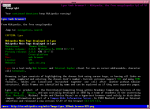 Developed by Sun Microsystems in the early 1990s, the Star7 was one of the earliest known handheld touchscreen devices. Although it never really made it past the prototype phase , it was innovative for it’s time and is widely considered one of the first PDAs.
Developed by Sun Microsystems in the early 1990s, the Star7 was one of the earliest known handheld touchscreen devices. Although it never really made it past the prototype phase , it was innovative for it’s time and is widely considered one of the first PDAs.
It sported gesture based interaction, and even wireless connectivity. Introduced a year before the Apple Newton, it was specifically designed to interact with televisions and provided a variety of functions to work with programming guides and other devices like VCRs. It was even capable of sharing content with other Star7 devices. Although Sun pitched it to various cable companies, it didn’t generate a lot of interest and was abandoned. Sun moved on to developing Java and the Star7 faded into history.






